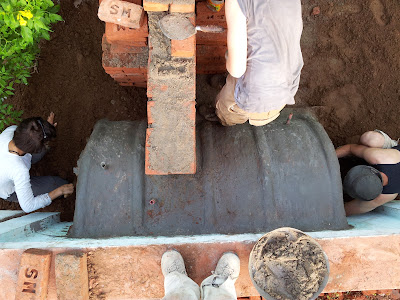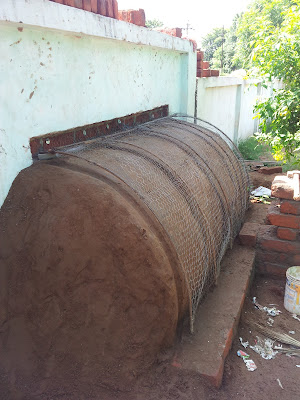A Sidewalk Barber Shop
Amongst
the tens of thousands of makeshift stalls in Ahmadabad streets I discovered two
makeshift barber shops.
One
of the shops had three seats while the second was only a single seat one. Both barber
shops were using the sidewalk as a floor and a plastic sheet as the roof (which
also defines the shop's territory). Both roofs where knotted to the fence
behind the shops.
In
each there is a shelf, hanging from the back fence, being the only fixed
furniture in the shop.
The resemblance between these two barber shops made
me wonder whether this is a known model for "a sidewalk barber shop",
or maybe those two examples are only the necessary solution for reducing a
common barber shop to its minimal space.
 |
| Barber shop A |
 |
| Barber shop B |
What Happens to the Street on a Rainy
Day ?
The
Monsoon season is a good opportunity to examine how the rain does affects the
streets of Ahmadabad.
 |
| Ahmedabad market befor the rain (left) and during the rain |
The
scenery changes within minutes as the first signs of the expected rainfall threaten
to wash off the street. The entire street is covered with a kind of colored tarpaulin
being used as improvised rooftops to protect the market stalls, the peddlers
and the others who reside in the street.
 |
| A stall which sells plastic covers |
Each
one quickly raises a light plastic and wires cover as a makeshift roof, tying
it to a fixed object, usually to an existing fence. This spread over sheet
helping the person looking from the side to understand the defined territory of
each such market stall and the boundaries of each temporary living area.
The movement in the street also changes with the
pouring rain; take the local market for instance; The market stalls which
are usually located on the pavement opening to the street turn their faces to
look toward the sidewalk, creating a temporary covered & dry passage to
enable the passing by to continue their wheelings and dealings without being
too affected by the pouring rain (Usually formed by stitched up tarpaulin
pieces stretched between the side shops to the stall). As the rain stops - the commerce goes back to
the street and the improvised rooftops disappear.
  |
| Temporary coveres passage |
Raised Rim for the Bowl
The
lady selling apples on board a local bus found her own spontaneous solution for
her need to carry a brimming apple bowl, attempting to prevent the apples from falling
off the bowl as she picks one out of the pile.
The
lady merchant padded the rim of the bowl using a simple brown cardboard thus creating a new peripheral rim approximately 15
cm higher than its original size, enabling expanding the bowl's capacity as
well as securing all the apples in the bowl she carries.
Dustbusters: When Hi-Tech meets Low
Tech.
It's
either unemployment or high awareness for maintenance? Two persons on a scaffold in Mumbai's Domestic Airport's terminal are dusting
off the enormous modern structural of the terminal's roof. Needless to say that
the flying dust falls from the roof on top of the people waking by, landing on
the pavement waiting for the cleaning people to collect it to the trash can.
This
very basic tool which is used for this task is nothing more than a house
feather duster (see attached photo) which was extended 8 times its standard
length (extended from 0.5 meter to about 4 meter long) by 4 plastic sticks
connected to each other by a simple plastic binder.





.jpg)


























